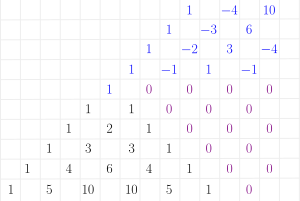Pascal's Triangle: Difference between revisions
| Line 92: | Line 92: | ||
* the second term is <math>\frac03 x^3</math>, <math>\frac13 x^3</math>, <math>\frac23 x^3</math>, <math>\frac33 x^3</math>, etc. | * the second term is <math>\frac03 x^3</math>, <math>\frac13 x^3</math>, <math>\frac23 x^3</math>, <math>\frac33 x^3</math>, etc. | ||
* Thus, because the numerator of the second term is separated by <math>1</math> he assumed that when adding the half-integers into the list, the separation will be <math>1/2</math>, also <math>0, \frac12, 1, \frac 32, \dots</math> | * Thus, because the numerator of the second term is separated by <math>1</math> he assumed that when adding the half-integers into the list, the separation will be <math>1/2</math>, also <math>0, \frac12, 1, \frac 32, \dots</math> | ||
So, this will give the the first and second term half-integer to be | |||
<math> | |||
\begin{align} | |||
y_1 &= (1-x^2)^{1/2} | |||
= x - \frac 13 \left( \frac12 x^2 \right) + \cdots | |||
\\ | |||
y_3 &= (1-x^2)^{3/2} | |||
= x - \frac 13 \left( \frac32 x^2 \right) + \cdots | |||
\\ | |||
y_5 &= (1-x^2)^{5/2} | |||
= x - \frac 13 \left( \frac52 x^2 \right) + \cdots | |||
\end{align} | |||
</math> | |||
Revision as of 19:46, 19 October 2022
Introduction
Binomial expansion
Pascal's triangle

The coefficients of binomial expansion can be easily seen from the Pascal triangle. The number is a sum of the two numbers above it.
Pascal's triangle: Negative right
This can be extended to negative numbers easily.

Now, instead of expanding , we will use , where is a negative integer. The exponent of each terms grows when going to left. We get according to the Pascal triangle
And by Taylor series (expansion at Laurent series) we get
- https://www.wolframalpha.com/input?i=series%28+%281%2Bx%29%5E%28-1%29+%29
- https://www.wolframalpha.com/input?i=series%28+%281%2Bx%29%5E%28-2%29+%29
- https://www.wolframalpha.com/input?i=series%28+%281%2Bx%29%5E%28-3%29+%29
Pascal's triangle: Negative left
The triangle can be extended to the left also, but it is symmetric to the earlier.
Pascal's triangle: half-integers
Newton: Find the area of the curve , because it is a quarter of a unit circle . He couldn't do that, so he took some other powers, and calculated the areas following Wallis and Fermat method that was known:
Newton noted that
- the first term is always
- The denominator is always an odd integer
- the second term is , , , , etc.
- Thus, because the numerator of the second term is separated by he assumed that when adding the half-integers into the list, the separation will be , also
So, this will give the the first and second term half-integer to be

















